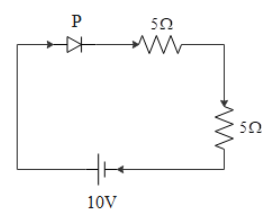
In the given circuit for ideal diode, the current through the battery is

(A) 0.5A
(B) 1.5A
(C ) 1.0A
(D) 2A

Answer
558.6k+ views
Hint: The diode is connected in forward bias. Here the two resistances are connected in series. Hence the total resistance of the circuit is the sum of those two resistances. Then by applying Ohm’s law and rearranging the equation and then substituting the values of voltage and total resistance of series connection we will get the current through the battery.
Formula used:
According to Ohm’s law the voltage or potential difference and the current flowing through a conductor are directly proportional. And here the proportionality constant is the resistance.
$V=IR$
where, V is the voltage or potential difference.
I is the current flowing through a conductor.
and R is the resistance.
Complete answer:
Here the two resistances are connected in series. Hence the total resistance of the circuit is the sum of those two resistances.
Given that ${{R}_{1}}=5\Omega \And {{R}_{2}}=5\Omega $ .
Thus ${{R}_{net}}={{R}_{1}}+{{R}_{2}}$
$\Rightarrow {{R}_{net}}=5+5$
$\therefore {{R}_{net}}=10\Omega $
According to Ohm’s law the voltage or potential difference and the current flowing through a conductor are directly proportional. And here the proportionality constant is the resistance.
$V=IR$ ………..(1)
where, V is the voltage or potential difference.
I is the current flowing through a conductor.
and R is the resistance.
Also given that V=10V
By calculation the net resistance, ${{R}_{net}}=10\Omega $
Then by rearranging the equation (1) and then substituting the values of voltage and total resistance of series connection we will get the current through the battery we get,
$I=\dfrac{V}{R}$
$\Rightarrow I=\dfrac{10V}{10\Omega }$
$\therefore I=1A$
Therefore option (C ) is correct.
Note:
According to Ohm’s law the voltage or potential difference and the current flowing through a conductor are directly proportional . And here the proportionality constant is the resistance. In a circuit if there is more than one resistor used, then first check whether they are connected in series or parallel. Then apply the equation according to it to find the total resistance of the combination.
Formula used:
According to Ohm’s law the voltage or potential difference and the current flowing through a conductor are directly proportional. And here the proportionality constant is the resistance.
$V=IR$
where, V is the voltage or potential difference.
I is the current flowing through a conductor.
and R is the resistance.
Complete answer:
Here the two resistances are connected in series. Hence the total resistance of the circuit is the sum of those two resistances.
Given that ${{R}_{1}}=5\Omega \And {{R}_{2}}=5\Omega $ .
Thus ${{R}_{net}}={{R}_{1}}+{{R}_{2}}$
$\Rightarrow {{R}_{net}}=5+5$
$\therefore {{R}_{net}}=10\Omega $
According to Ohm’s law the voltage or potential difference and the current flowing through a conductor are directly proportional. And here the proportionality constant is the resistance.
$V=IR$ ………..(1)
where, V is the voltage or potential difference.
I is the current flowing through a conductor.
and R is the resistance.
Also given that V=10V
By calculation the net resistance, ${{R}_{net}}=10\Omega $
Then by rearranging the equation (1) and then substituting the values of voltage and total resistance of series connection we will get the current through the battery we get,
$I=\dfrac{V}{R}$
$\Rightarrow I=\dfrac{10V}{10\Omega }$
$\therefore I=1A$
Therefore option (C ) is correct.
Note:
According to Ohm’s law the voltage or potential difference and the current flowing through a conductor are directly proportional . And here the proportionality constant is the resistance. In a circuit if there is more than one resistor used, then first check whether they are connected in series or parallel. Then apply the equation according to it to find the total resistance of the combination.
Recently Updated Pages
Master Class 11 Business Studies: Engaging Questions & Answers for Success

Master Class 11 Computer Science: Engaging Questions & Answers for Success

Master Class 11 Maths: Engaging Questions & Answers for Success

Master Class 11 Chemistry: Engaging Questions & Answers for Success

Master Class 11 Economics: Engaging Questions & Answers for Success

Master Class 11 Accountancy: Engaging Questions & Answers for Success

Trending doubts
What is meant by exothermic and endothermic reactions class 11 chemistry CBSE

10 examples of friction in our daily life

One Metric ton is equal to kg A 10000 B 1000 C 100 class 11 physics CBSE

1 Quintal is equal to a 110 kg b 10 kg c 100kg d 1000 class 11 physics CBSE

Difference Between Prokaryotic Cells and Eukaryotic Cells

What are Quantum numbers Explain the quantum number class 11 chemistry CBSE




